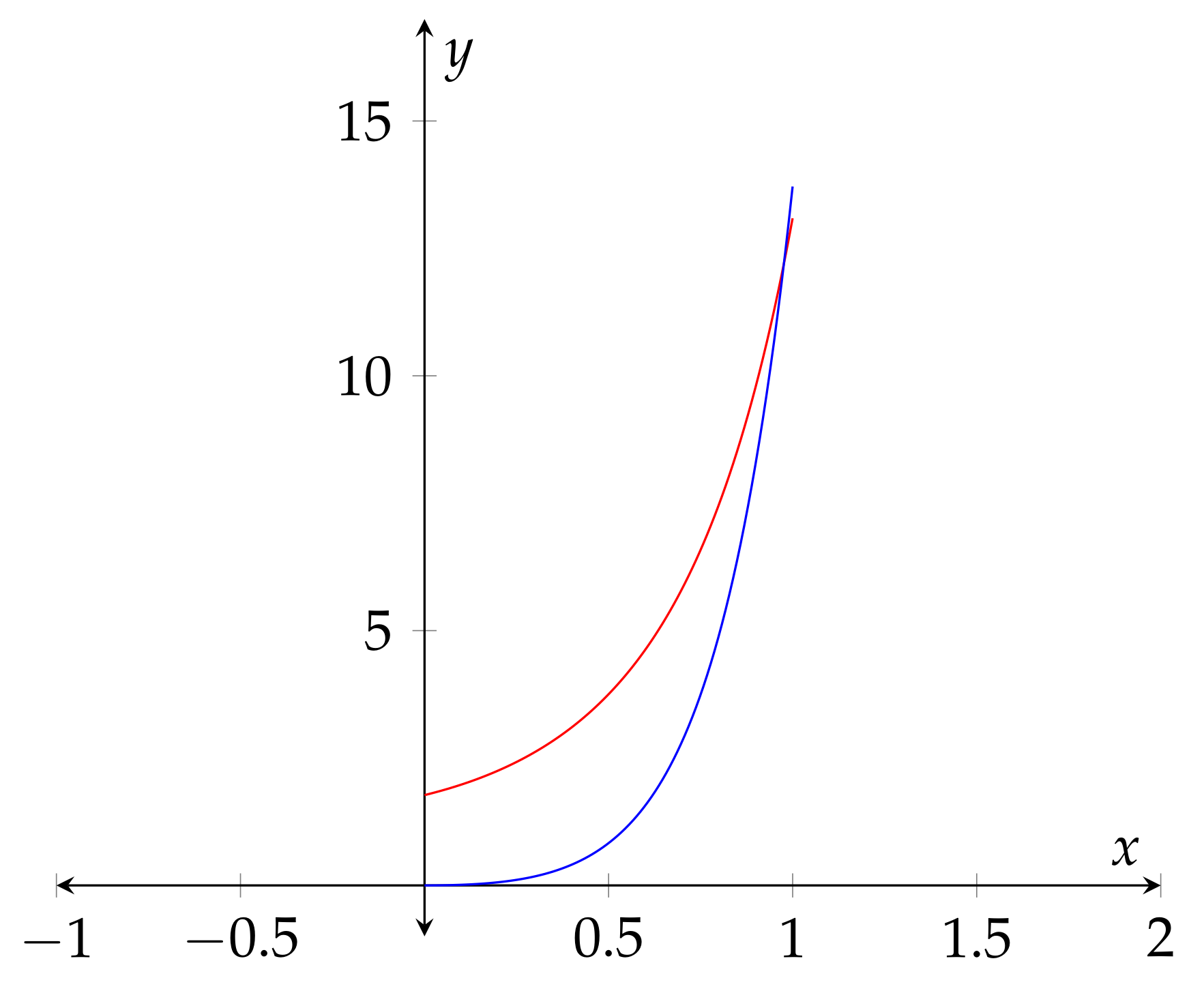Hyers–Ulam–Rassias Stability of Hermite’s Differential Equation
Abstract
:1. Introduction
2. Preliminary Notions and Results
- 1.
- 2.
- 1.
- 2.
- where .
3. Hyers–Ulam–Rassias Stability of Hermite’s Equation
4. Generalized Hyers–Ulam–Rassias Stability of Hermite’s Equation
- (i)
- such that
- (ii)
- is increasing;
5. Conclusions
Author Contributions
Funding
Conflicts of Interest
References
- Corduneanu, A. Ecuatii Diferentiale cu Aplicatii in Electrotehnica; Editura Facla: Timisoara, Romania, 1981. [Google Scholar]
- Blaga, F.; Mesaroş, L.; Popa, D.; Pugna, G.; Rasa, I. Bounds for solutions of linear differential equations and Ulam stability. Miskolc Math. Notes 2020, 21, 653–664. [Google Scholar] [CrossRef]
- Pachpatte, B.G. Inequalities for Differential and Integral Equations, Mathematics in Science and Engineering; Academic Press: San Diego, CA, USA, 1997; Volume 197. [Google Scholar]
- Ulam, S.M. A Collection of Mathematical Problems; Interscience: New York, NY, USA, 1960. [Google Scholar]
- Hyers, D.H. On the stability of the linear functional equation. Proc. Natl. Acad. Sci. USA 1941, 27, 222–224. [Google Scholar] [CrossRef] [Green Version]
- Obloza, M. Hyers stability of the linear differential equation. Rocz. Nauk-Dydakt. Pr. Mat. 1993, 13, 259–270. [Google Scholar]
- Alsina, C.; Ger, R. On some inequalities and stability results related to exponential function. J. Inequal. Appl. 1998, 2, 373–380. [Google Scholar] [CrossRef]
- Takahasi, S.E.; Takagi, H.; Miura, T.; Miyajima, S. The Hyers-Ulam stability constant of first order linear differential operators. J. Math. Anal. Appl. 2004, 296, 403–409. [Google Scholar] [CrossRef] [Green Version]
- Jung, S.-M. Hyers–Ulam stability of linear differential equations of first order. Appl. Math. Lett. 2004, 17, 1135–1140. [Google Scholar] [CrossRef] [Green Version]
- Jung, S.-M. Hyers–Ulam stability of linear differential equations of first order, II. Appl. Math. Lett. 2006, 19, 854–858. [Google Scholar] [CrossRef] [Green Version]
- Jung, S.-M. Hyers-Ulam stability of linear differential equations of first order, III. J. Math. Anal. Appl. 2005, 311, 139–146. [Google Scholar] [CrossRef] [Green Version]
- Jung, S.-M. Hyers–Ulam stability of linear partial differential equations of first order. Appl. Math. Lett. 2009, 22, 70–74. [Google Scholar] [CrossRef] [Green Version]
- Cimpean, D.S.; Popa, D. On the stability of the linear differential equation of higher order with constant coefficients. Appl. Math. Comput. 2010, 217, 4141–4146. [Google Scholar] [CrossRef]
- Novac, A.; Otrocol, D.; Popa, D. Ulam stability of a linear difference equation in locally convex spaces. Results Math. 2021, 76, 33. [Google Scholar] [CrossRef]
- Rus, I.A. Ulam stability of ordinay differential equations. Studia Univ. Babes-Bolyai Math. 2009, LIV, 125–133. [Google Scholar]
- Wang, X.; Luo, D.; Zhu, Q. Ulam-Hyers stability of caputo type fuzzy fractional differential equations with time-delays. Chaos Solitons Fractals 2022, 156, 111822. [Google Scholar] [CrossRef]
- Brzdek, J.; Popa, D.; Rasa, I.; Xu, B. Ulam Stability of Operators; Elsevier: Amsterdam, The Netherlands, 2018. [Google Scholar]
- Tripathy, A.K. Hyers–Ulam Stability of Ordinary Differential Equations; Taylor and Francis: Boca Raton, FL, USA, 2021. [Google Scholar]
- Li, Y.; Shen, Y. Hyers–Ulam stability of linear differential equations of second order. Appl. Math. Lett. 2010, 23, 306–309. [Google Scholar] [CrossRef] [Green Version]
- Li, Y.; Shen, Y. Hyers–Ulam stability of nonhomogeneous linear differential equations of second order. Int. J. Math. Math. Sci. 2009, 2009, 576852. [Google Scholar] [CrossRef] [Green Version]
- Alqifiary, Q.H.; Jung, S.-M. On the Hyers–Ulam stability of differential equations of second order. Abstr. Appl. Anal. 2014, 2014, 483707. [Google Scholar] [CrossRef]
- Gavruta, P.; Jung, S.-M. Hyers–Ulam stability for second-order linear differential equations with boundary conditions. Electron. J. Differ. Equ. 2011, 80, 1–5. [Google Scholar]
- Modebei, M.I.; Olaiya, O.O.; Otaide, I. Generalized Hyers–Ulam stability of second order linear ordinary differential equations with initial condition. Adv. Inequal. Appl. 2014, 2014, 36. [Google Scholar]
- Aruldass, A.R.; Pachaiyappan, D.; Park, C. Hyers–Ulam stability of second-order differential equations using Mahgoub transform. Adv. Differ. Equ. 2021, 2021, 23. [Google Scholar] [CrossRef]
- Javadian, A.; Sorouri, E.; Kim, G.H.; Godji, M.E. Generalized Hyers–Ulam stability of the second-order linear differential equations. J. Appl. Math. 2011, 2011, 813137. [Google Scholar] [CrossRef] [Green Version]
- Qarawani, M.N. Hyers–Ulam stability of a generalized second order nonlinear differential equation. Appl. Math. 2012, 3, 1857–1861. [Google Scholar] [CrossRef] [Green Version]
- Fakunle, I.; Arawomo, P.O. Hyers–Ulam stability of certain class of nonlinear second order differential equations. Int. J. Pure Appl. Math. Sci. 2018, 11, 55–65. [Google Scholar]
- Ionescu, D.V. Ecuatii Diferentiale si Integrale; Editura Didactica si Pedagogica: Bucuresti, Romania, 1964. [Google Scholar]

Publisher’s Note: MDPI stays neutral with regard to jurisdictional claims in published maps and institutional affiliations. |
© 2022 by the authors. Licensee MDPI, Basel, Switzerland. This article is an open access article distributed under the terms and conditions of the Creative Commons Attribution (CC BY) license (https://creativecommons.org/licenses/by/4.0/).
Share and Cite
Marian, D.; Ciplea, S.A.; Lungu, N. Hyers–Ulam–Rassias Stability of Hermite’s Differential Equation. Mathematics 2022, 10, 964. https://doi.org/10.3390/math10060964
Marian D, Ciplea SA, Lungu N. Hyers–Ulam–Rassias Stability of Hermite’s Differential Equation. Mathematics. 2022; 10(6):964. https://doi.org/10.3390/math10060964
Chicago/Turabian StyleMarian, Daniela, Sorina Anamaria Ciplea, and Nicolaie Lungu. 2022. "Hyers–Ulam–Rassias Stability of Hermite’s Differential Equation" Mathematics 10, no. 6: 964. https://doi.org/10.3390/math10060964
APA StyleMarian, D., Ciplea, S. A., & Lungu, N. (2022). Hyers–Ulam–Rassias Stability of Hermite’s Differential Equation. Mathematics, 10(6), 964. https://doi.org/10.3390/math10060964





